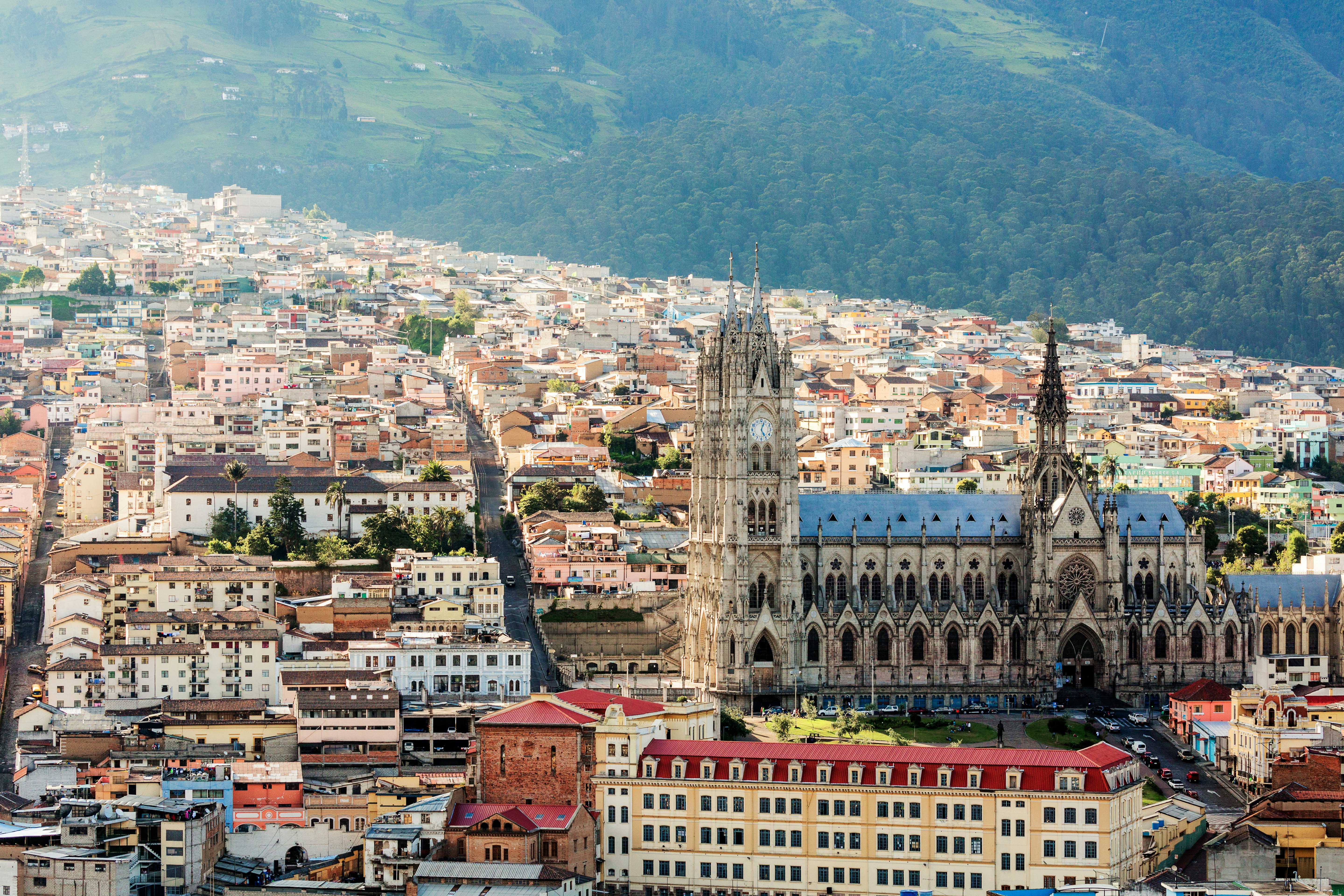

Flying is expensive but it's the quickest way to get to the Galapagos Islands © Matt Henry Gunthernau / Getty Images
Ecuador’s irregular topography and geographical richness are some of the top reasons travelers choose to visit the South American nation. However, when it comes to navigating around its territory, the same qualities pose challenges for visitors.
Thankfully, Ecuador’s straightforward road system, affordable gas prices and budget-friendly overland transportation ease the hurdles of moving around the country.
Air travel is expensive, but saves time
Traveling to Ecuador by plane is not nearly as cheap as flying to neighboring nations. The country’s taxes and high airfare fees are a hindrance for everyone, particularly residents looking to fly domestically.
Regardless, flying remains one of the less time-consuming options to travel between the main cities (Quito, Guayaquil and Cuenca), which otherwise takes up to 13 hours on the road.
Flying is also one of the few options to visit the Galápagos Islands — cruises are also available, but planes are by far the cheapest and most popular way of getting there.
Expect prices to fluctuate between US$150 to $250 for round-trip flights in mainland territory and about twice that for trips to the Galápagos Islands. LATAM is a popular airline among locals for internal flights.

Buses will take you nearly anywhere
A solid alternative to moving between cities and skipping planes is hopping on a bus. Much like in the rest of South America, buses are a preferred and reliable means of transportation for locals due to their reach — most cities and towns have designated areas or central bus stations (terminal terrestre).
Ecuador’s easy-to-travel size will keep trips short and not overly taxing. Prices depend on the distance between destinations, but the longest rides – for example, from Huaquillas on the border with Peru to Carchi on the border with Colombia – could last up to 15 hours and cost between US$25 and $30.
Shorter trips between neighboring towns and cities start at $3. If you’re on a budget, traveling long distances at night might help you save a few bucks on accommodation.
Picking a bus company for your trip will depend on the available routes according to your departure and destination points. Flota Imbabura (pet-friendly) and Transportes Occidentales are some of the transportation companies offering routes that traverse the country.
Take your time researching as some units might not offer a lot of amenities — though wifi, reclinable seats, and in a few cases, restrooms are increasingly common.
Always keep an eye on your belongings and hide any valuables when traveling by bus. Conversely, keep documents on hand in case the bus stops for military checkpoints.
Due to the current security crisis in Ecuador, it’s best to opt for transport companies that don’t stop on the road to pick up more passengers or hire private transportation companies such as JL Turismo Transporte, which provides options for both individuals and groups of up to 45 people. If your budget allows it, another safe alternative is tailoring a bespoke route on hop-on/hop-off bus tours.
In contrast to intercity and interregional traveling, bus transportation within cities can be trickier. Routes are rarely listed in detail, there are no scheduled time slots for buses to arrive and sometimes you’ll need to ride more than one bus to arrive at your destination.
Fees, however, are inexpensive and range from US $0.35 to $1, depending on the city and destination — traveling from urban centers to rural parishes is more expensive.

Opt for urban transport if you’re on a budget
In cities such as Quito and Guayaquil, bus rapid transit (BRT) systems like Trolebus (trolleybus) and Metrovía will offer a more organized alternative as you tour urban centers.
However, don’t expect the experience to be particularly comfortable during rush hours as people often opt for BRT because it’s quicker.
Quito’s newly debuted underground system, Metro de Quito, has steadily become a time-saving choice for traversing the city.
It takes about 34 minutes to cross from north to south, with stops at 15 key points in the city, including Parque La Carolina, Universidad Central (one of the biggest national universities in Ecuador) and Plaza de San Francisco in the historic center.
Although having a transportation card for the Metro will save you time queuing, you won’t need one to ride the trains. All you’ll need is some cash (US$0.45 for a one-way ticket).
Cash is also the preferred method for paying on buses and most urban transportation systems so don’t forget to carry pocket change if you plan to ride any of them. One of the exceptions is Cuenca’s modern and comfortable tramway, which is only accessible with a card that can be purchased at the tramway stops.

If you want to discover Ecuador at your own pace, rent a car
Visitors who favor independence and flexibility should rent a car. Budget-friendly petrol prices and relatively easy-to-navigate roads make rentals a good option.
Car rental requirements will vary according to companies, but a driving license and passport will suffice for those over 25. Younger people might need to pay a surety in some rental places.
Agencies such as Avis, Europcar and Goldcar are easy to find. They’re generally located at major airports in big cities or close to transport hubs in smaller cities – make sure to search online for the best addresses and to check their car availability before landing in the country.
If you’re renting only to get around a city, a standard sedan will fit the bill. However, if you aim to use the rental to explore Ecuador’s majestic landscapes, consider a 4WD vehicle (an added expense).
While on the road, be mindful of Ecuadorians’ sometimes dangerous driving habits. Speeding, changing lanes abruptly or illegal passing aren't rare occurrences on Ecuadorian roads. Keep a defensive attitude and avoid getting too close to larger vehicles such as buses and trucks, as these drivers often disregard speed limits.
Always check weather updates and pack a physical map, especially if you’re venturing into tiny towns and remote places where cell reception is unstable.
For your safety, be cautious when traveling on the coast. Don’t stop by isolated places, try not to veer away from main roads and if possible, avoid driving at night.

Taxis and apps are the easiest way to get around – and they’re quite affordable
If you’re unsure about public transportation, taxis and apps like Uber are an easy-to-use and affordable means of transportation. As a safety measure, verify that the cars you ride all have a plate.
If you’re opting for an app, check that the license plate number matches the number listed online. Since March 2023, Uber users have benefited from an additional safety layer.
To make sure they get in the assigned vehicle, users receive a 4-digit PIN code that the driver must confirm in order to start the trip.
In major cities, taxis generally work with a meter, so make sure the device is on when you set off. In small cities and towns, most taxis have a standard (and super affordable) fee that shouldn’t surpass US$3 regardless of the distance.
When in doubt, ask your travel guide or hotel staff for recommendations as many work with trusted and reliable taxi or transportation companies.
Accessible transportation
Just like many Latin American countries, providing accessible transportation remains a challenge for Ecuador. Wheelchair-friendly transportation is limited to a few public transportation systems like BRT systems and the Metro in Quito.
Most urban transportation companies operate with step-entrance buses and are not adapted for wheelchairs. However, some interregional companies might provide space and special help upon request.
The best option for travelers with disabilities is to book accessible tours with companies like Latin America For All which specializes in crafting tour experiences for people with disabilities and their travel companions.
















